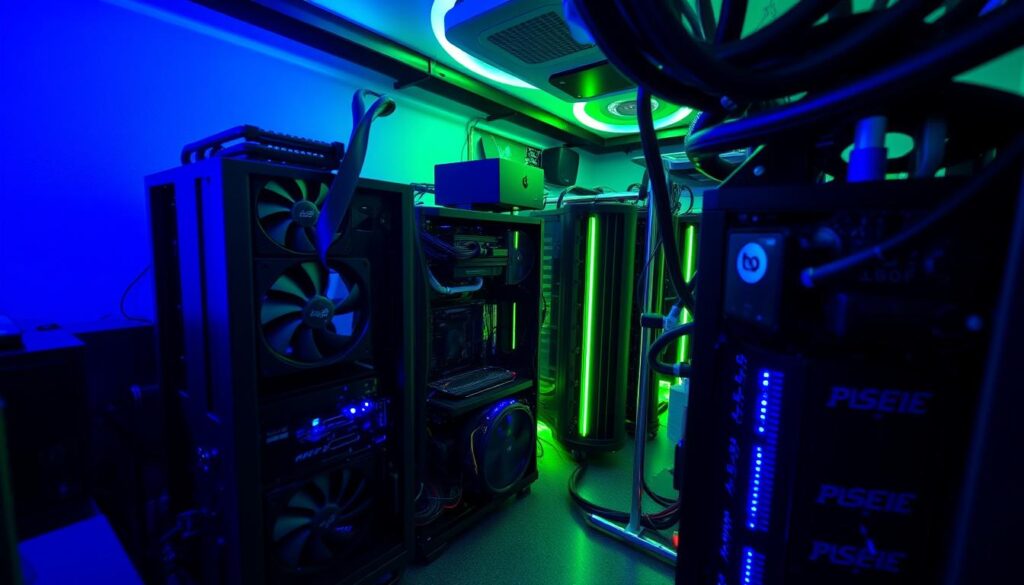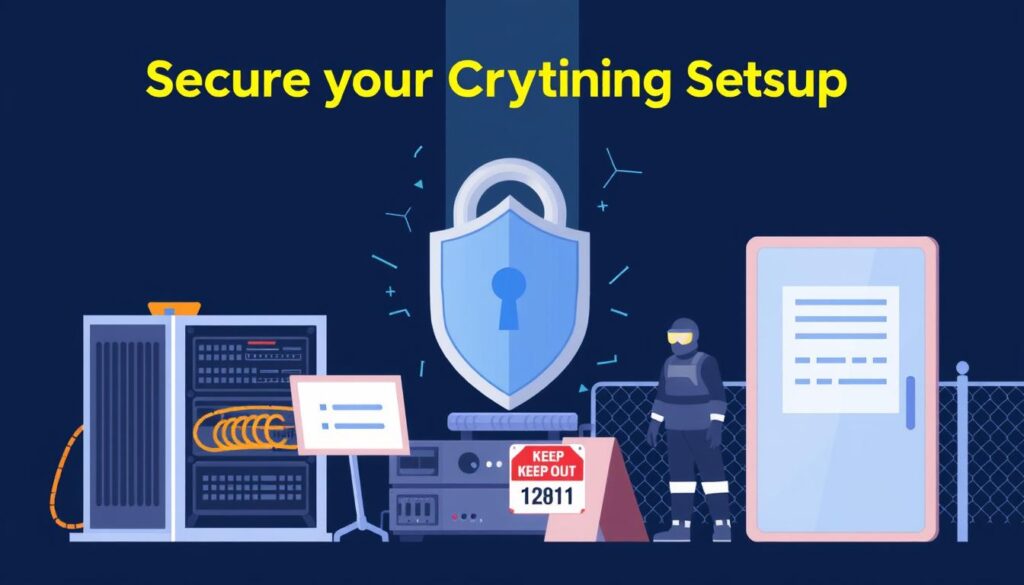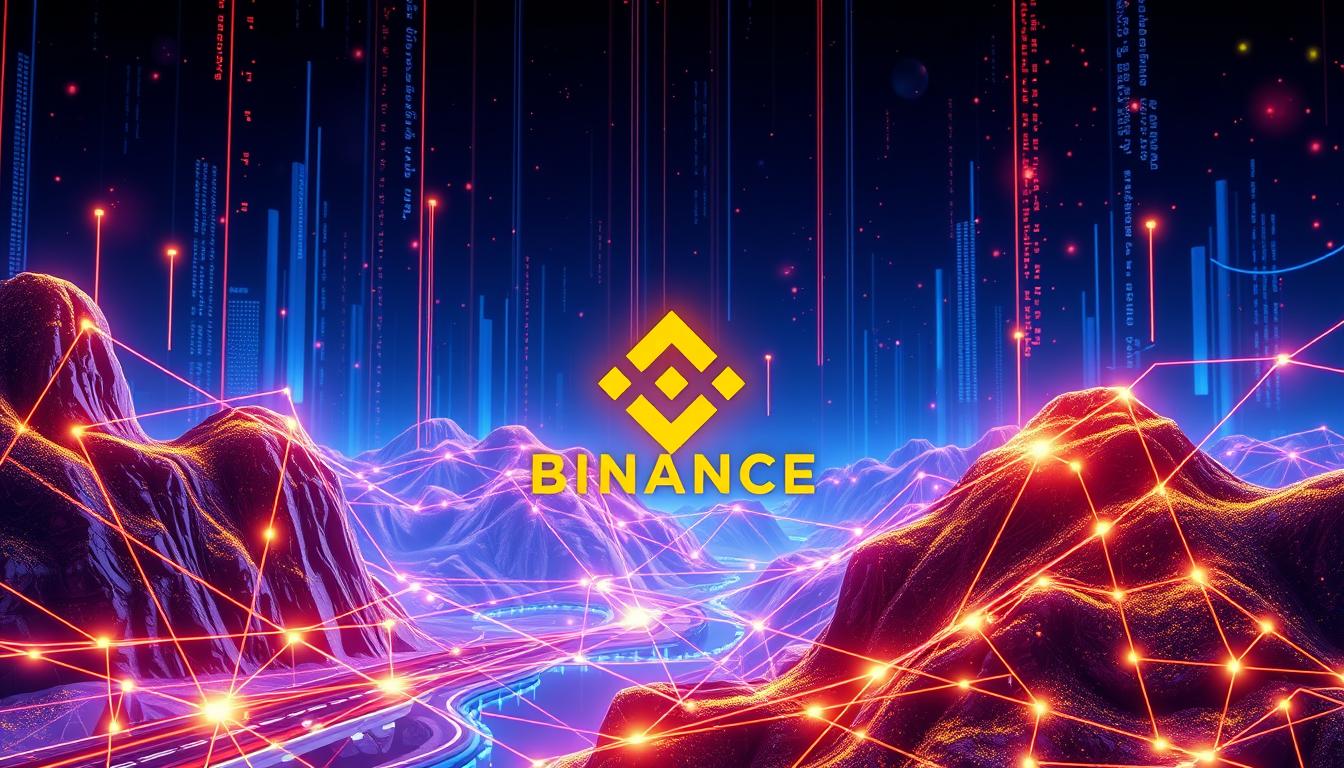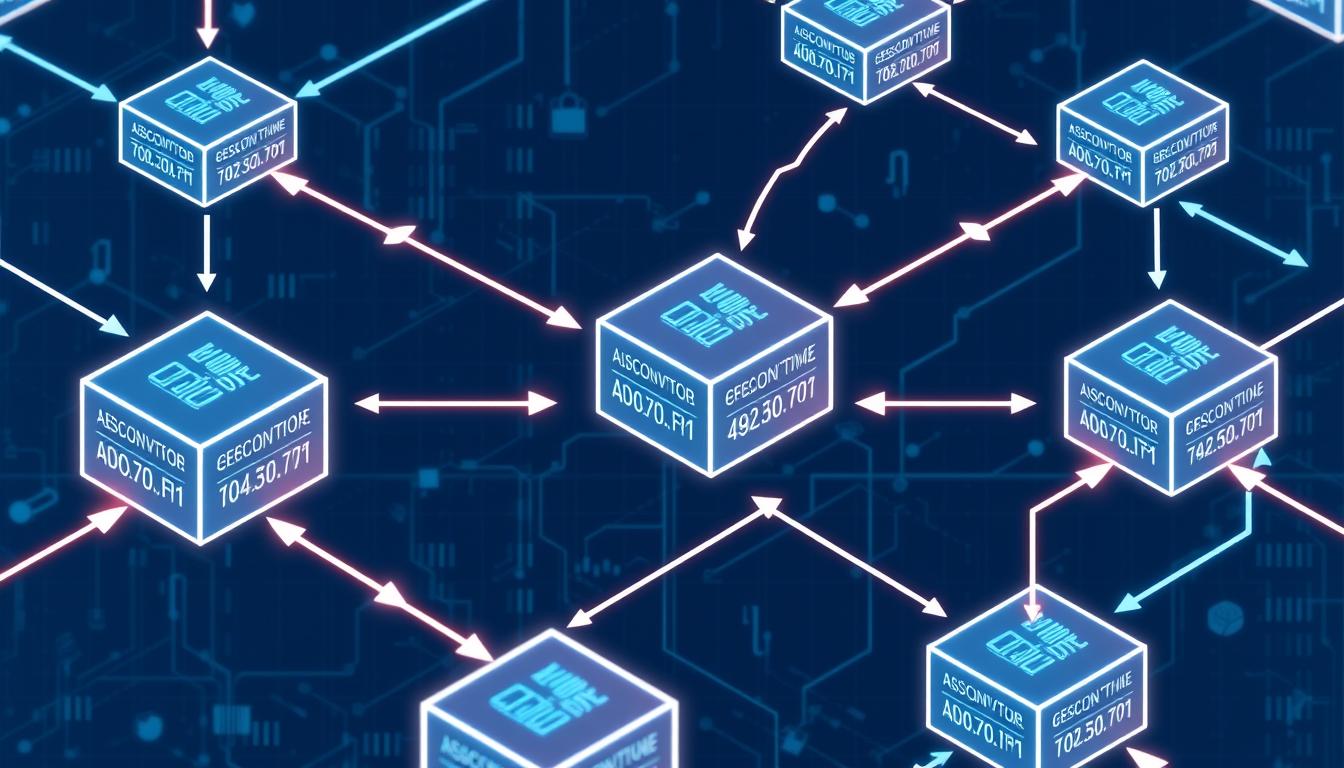Now Reading: Ultimate Crypto Mining Setup Guide for Beginners
- 01
Ultimate Crypto Mining Setup Guide for Beginners
Ultimate Crypto Mining Setup Guide for Beginners

Cryptocurrency mining has become an increasingly popular way for individuals to participate in the digital asset revolution. Whether you’re new to the world of crypto or an experienced enthusiast, setting up a successful mining operation requires a solid understanding of the hardware, software, and operational considerations involved. This comprehensive guide will walk you through the essential steps to build a profitable Crypto Mining Rig, select the right Mining Hardware, configure your Mining Software, and optimize your mining setup for maximum efficiency and returns.
Key Takeaways
- Discover the fundamentals of Crypto Mining and the benefits of participating in the cryptocurrency ecosystem.
- Learn how to evaluate and select the optimal Mining Hardware, including GPUs and ASIC miners, based on your specific needs and mining goals.
- Understand the process of joining a Mining Pool and configuring your mining software to start earning rewards.
- Explore strategies for Power Consumption Optimization and effective Cooling System design to maximize your mining rig’s efficiency.
- Discover the advantages of scaling your mining operations with a Mining Farm Setup for larger-scale crypto mining.
Introduction to Crypto Mining
In the dynamic world of digital currencies, crypto mining plays a crucial role in maintaining the integrity and security of blockchain networks. This process involves using computational power to verify and add transactions to the blockchain, ultimately generating new units of a cryptocurrency as a reward for miners’ efforts.
What is Crypto Mining?
Crypto mining is the process of solving complex mathematical problems to validate transactions and add them to the blockchain, the distributed digital ledger that records all cryptocurrency activities. Miners use specialized hardware and software to compete in solving these cryptographic puzzles, with the successful miner receiving a reward in the form of newly created cryptocurrency tokens.
Benefits of Mining Cryptocurrencies
- Earning Passive Income: Crypto mining can provide a steady stream of passive income for those willing to invest in the necessary hardware and energy-efficient mining setups.
- Supporting the Blockchain Ecosystem: By verifying transactions and maintaining the blockchain, miners play a vital role in the overall health and decentralization of the cryptocurrency network.
- Exposure to Emerging Digital Assets: Crypto mining allows individuals to gain exposure to a diverse range of digital assets, potentially providing opportunities for investment and growth as the cryptocurrency market continues to evolve.
The process of crypto mining is essential for the operation and security of blockchain-based digital currencies, making it an increasingly attractive option for those looking to participate in the rapidly expanding world of decentralized finance.
Understanding Crypto Mining Rigs
Crypto mining rigs are the backbone of the cryptocurrency mining industry. These specialized computer systems are designed to efficiently process complex mathematical calculations required for mining various digital currencies. Understanding the core components and architecture of a typical crypto mining rig is essential for selecting the right hardware and configuring it for optimal performance.
At the heart of a crypto mining rig is a powerful motherboard that can accommodate multiple high-performance graphics processing units (GPUs) or application-specific integrated circuits (ASICs). The processor, often an energy-efficient CPU, plays a crucial role in managing the mining operations and coordinating the rig’s overall performance. The graphics cards, typically featuring the latest GPU technology, are responsible for the intensive computational tasks required for mining.
An efficient power supply unit (PSU) is a critical component, providing the necessary electrical power to the various components of the mining rig. Cooling systems, including fans and heatsinks, are essential to maintain the optimal operating temperatures and prevent overheating, which can significantly impact the rig’s efficiency and lifespan.
Understanding the intricate design and architecture of Crypto Mining Rigs is the first step towards building a successful and profitable mining setup. By familiarizing themselves with the key components and their roles, aspiring miners can make informed decisions when selecting and configuring their mining hardware.
“Crypto mining rigs are the engines that power the decentralized blockchain network, enabling the secure verification and recording of transactions.”
Selecting the Right Mining Hardware
When it comes to cryptocurrency mining, the choice of mining hardware can significantly impact your profitability. Two popular options are GPU-based miners and ASIC (Application-Specific Integrated Circuit) miners. Understanding the pros and cons of each can help you make an informed decision that aligns with your mining goals and budget.
GPU vs ASIC Miners
GPU-based miners offer greater flexibility and can be used to mine a variety of cryptocurrencies. They are often more accessible and can be repurposed for other computing tasks. However, GPU miners generally consume more power and produce more heat, which can increase your operating costs.
On the other hand, ASIC miners are designed specifically for a single cryptocurrency algorithm, making them highly efficient at mining that particular coin. ASIC miners are typically more energy-efficient and can provide a higher hash rate, but they are often more expensive and cannot be easily adapted to mine other cryptocurrencies.
Evaluating Mining Profitability
To determine the profitability of your mining setup, it’s essential to consider various factors, such as the hash rate of your hardware, the current network difficulty, electricity costs, and the prevailing cryptocurrency prices. Utilizing mining profitability calculators can help you estimate your potential earnings and make informed decisions about your mining investments.
| Metric | GPU Miners | ASIC Miners |
|---|---|---|
| Flexibility | High | Low |
| Power Efficiency | Moderate | High |
| Hash Rate | Moderate | High |
| Cost | Moderate | High |
By carefully weighing the advantages and disadvantages of GPU-based and ASIC miners, along with a thorough evaluation of mining profitability, you can make an informed decision on the ideal mining hardware for your cryptocurrency mining endeavors.
Choosing a Mining Pool
When delving into the world of Crypto Mining Pool Selection, it’s essential to choose the right mining pool to maximize your cryptocurrency mining efforts. Mining pools are groups of miners who combine their computational resources to increase the chances of successfully validating a block and earning the associated rewards. Selecting the optimal mining pool can significantly impact your overall mining profitability.
To help you navigate the process of choosing a suitable mining pool, consider the following key factors:
- Pool Fees: Compare the fees charged by different mining pools, as this can significantly affect your earnings. Look for pools with low fees or even no fees to maximize your returns.
- Payout Methods: Examine the payout methods offered by the mining pools, such as a proportional or pay-per-share system, and choose the one that aligns best with your preferences and mining strategy.
- Reputation and Reliability: Research the overall reputation and reliability of the mining pools you’re considering. Look for pools with a proven track record of consistent payouts and stable operations.
- Pool Size: Consider the size of the mining pool, as larger pools typically have a higher chance of successfully validating blocks, but smaller pools may offer a more equitable distribution of rewards.
- Geographical Distribution: Opt for mining pools with a diverse geographical distribution of nodes, as this can help mitigate the impact of regional outages or regulatory changes.
By carefully evaluating these factors, you can make an informed decision and select a Crypto Mining Pool that aligns with your mining goals and maximizes your chances of earning consistent cryptocurrency rewards.

“Choosing the right mining pool can make all the difference in your cryptocurrency mining journey.”
Setting Up Your Mining Software
Configuring the right crypto mining software is a crucial step in establishing an efficient mining operation. This section will explore the most popular mining software options, highlighting their features, compatibility, and ease of use. We’ll guide you through the installation and configuration process to ensure your mining rig is set up for optimal Crypto Mining Software Configuration performance.
Popular Mining Software Options
When it comes to Crypto Mining Software Configuration, there are several software options available, each with its own set of advantages and considerations. Let’s take a closer look at some of the most widely used mining software:
- Ethminer – A command-line Ethereum mining tool known for its efficiency and flexibility.
- CGMiner – A cross-platform mining software that supports a variety of cryptocurrencies and GPU/ASIC hardware.
- Claymore’s Dual Miner – A popular choice for mining Ethereum and Ethereum Classic simultaneously, offering improved performance.
- Phoenix Miner – A robust mining software that prioritizes stability and compatibility with a wide range of hardware configurations.
Each of these mining software options offers unique features and benefits, so it’s essential to research and evaluate them based on your specific Crypto Mining Software Configuration requirements and hardware setup.
| Mining Software | Supported Cryptocurrencies | Compatibility | Key Features |
|---|---|---|---|
| Ethminer | Ethereum | Windows, Linux | Efficient, command-line interface |
| CGMiner | Bitcoin, Litecoin, Altcoins | Windows, Linux, macOS | Supports GPU/ASIC, customizable settings |
| Claymore’s Dual Miner | Ethereum, Ethereum Classic | Windows, Linux | Dual mining capability, improved performance |
| Phoenix Miner | Ethereum, Ethereum Classic | Windows, Linux | Stable, compatible with various hardware |
By carefully selecting the right mining software and configuring it properly, you can optimize your Crypto Mining Software Configuration and maximize the efficiency of your mining operations.
Power Consumption and Cooling Considerations
Crypto mining rigs can be power-hungry and generate significant heat, which can impact the overall efficiency and longevity of your mining setup. Optimizing power efficiency and implementing effective cooling solutions are crucial for maintaining a stable and cost-effective mining operation.
Optimizing Power Efficiency
Reducing power consumption is essential for maximizing Power Consumption Optimization and profitability in crypto mining. Here are some strategies to consider:
- Selecting energy-efficient mining hardware, such as ASICs or the latest GPU models, can significantly improve power efficiency.
- Monitoring and managing your mining rig’s power consumption by using power management tools or software can help you identify and address areas of high energy usage.
- Optimizing your mining software settings, such as adjusting clock speeds and voltage levels, can further enhance power efficiency without compromising performance.
- Implementing energy-saving measures, like undervolting your GPU or CPU, can reduce power draw without sacrificing hash rate.
“Careful power management is the key to running a profitable and sustainable crypto mining operation.” – Crypto Mining Expert
Cooling System for Miners
Effective Cooling System for Miners is essential to prevent overheating and maintain the longevity of your mining hardware. Here are some cooling solutions to consider:
- Utilize high-quality case fans or liquid cooling systems to ensure adequate airflow and heat dissipation.
- Position your mining rig in a well-ventilated area with proper air circulation to minimize the risk of overheating.
- Consider investing in specialized mining rigs or enclosures designed with advanced cooling systems to optimize thermal management.
- Monitor your mining rig’s temperature regularly and take immediate action to address any overheating issues.

By addressing power consumption and cooling considerations, you can optimize the efficiency and reliability of your crypto mining setup, ensuring a stable and profitable operation.
Crypto Mining Setup Guide
Setting up your crypto mining operation can be a rewarding yet intricate process. In this comprehensive guide, we’ll walk you through the essential steps to get your Crypto Mining Setup up and running efficiently. From assembling the hardware components to configuring the mining software and joining a mining pool, we’ve got you covered.
Assembling the Hardware
The foundation of a successful Crypto Mining Setup is the mining rig itself. Start by carefully selecting the right GPU or ASIC miners based on your budget and the cryptocurrency you plan to mine. Ensure you have the necessary power supplies, cooling systems, and motherboards to support your chosen hardware.
- Choose the appropriate mining hardware (GPU or ASIC)
- Assemble the mining rig, including the power supply and cooling system
- Connect the hardware and test the setup for optimal performance
Configuring the Mining Software
With your mining rig in place, it’s time to set up the mining software. Research and select a reputable mining software solution that supports the cryptocurrency you’re mining. Follow the software’s instructions to configure your mining settings, including your wallet address and mining pool details.
- Install and set up the mining software
- Configure your wallet address and mining pool details
- Optimize the software settings for maximum efficiency
Joining a Mining Pool
To increase your chances of earning consistent rewards, consider joining a mining pool. Research and compare different mining pools based on their fees, reputation, and the cryptocurrencies they support. Follow the pool’s instructions to connect your mining rig and start contributing to the pool’s collective mining efforts.
By following these steps, you’ll be well on your way to setting up a robust and efficient Crypto Mining Setup. Remember to regularly monitor and optimize your system’s performance to ensure maximum profitability and reliability.
Mining Farm Setups for Larger Operations
As crypto miners seek to scale their operations, setting up a dedicated mining farm becomes a crucial consideration. A mining farm is a centralized facility housing multiple mining rigs, optimized for efficient power distribution, cooling, and remote management. Designing an effective mining farm setup requires careful planning and attention to several key factors.
Power and Cooling Considerations
One of the primary challenges in establishing a mining farm is ensuring reliable and efficient power supply and cooling. Mining rigs can be power-hungry, necessitating robust electrical infrastructure and meticulous power distribution planning. Implementing advanced cooling solutions, such as specialized HVAC systems or liquid cooling, is crucial to maintain optimal operating temperatures and prevent thermal throttling of the mining hardware.
Rig Placement and Rack Systems
Arranging the mining rigs in a strategic layout is essential for maximizing space utilization and airflow. Utilizing rack systems can help organize the mining equipment, facilitating easier maintenance and management. Careful consideration of rig placement, cable management, and airflow patterns can significantly enhance the overall efficiency and scalability of the mining farm.
Remote Monitoring and Management
A well-designed mining farm should incorporate robust remote monitoring and management capabilities. This allows operators to oversee the performance, temperature, and health of the mining rigs from a central location, enabling them to make timely adjustments and respond to any issues that may arise.
| Feature | Benefit |
|---|---|
| Centralized Power Distribution | Improved energy efficiency and cost savings |
| Automated Cooling Systems | Optimal operating temperatures for mining rigs |
| Rack-based Rig Placement | Enhanced space utilization and easier maintenance |
| Remote Monitoring and Management | Real-time oversight and proactive issue resolution |
By addressing these key considerations in the mining farm setup, crypto miners can unlock the benefits of increased scalability, improved operational efficiency, and enhanced profitability.
“Efficient mining farm setups are the key to unlocking the full potential of large-scale crypto mining operations.”
Troubleshooting Common Mining Issues
Crypto mining can occasionally encounter various issues, and being able to identify and resolve them is crucial for maintaining the efficiency and profitability of your mining operation. In this section, we’ll explore some of the most common mining-related problems and provide guidance on how to address them.
Hardware Failures
One of the most common issues faced by crypto miners is hardware failures. This can include GPU malfunctions, power supply issues, or even complete rig breakdowns. To troubleshoot hardware failures, it’s essential to regularly monitor your mining equipment and perform routine maintenance. Additionally, having a backup plan, such as spare parts or a secondary mining rig, can help minimize downtime and ensure your mining operation remains operational.
Software Glitches
Troubleshooting Crypto Mining Issues can also involve resolving software-related problems. This may include issues with mining software, driver conflicts, or network connectivity. Keep your mining software up-to-date, and be sure to follow the manufacturer’s instructions for proper installation and configuration. Additionally, stay informed about the latest updates and patches to ensure your system is running at its best.
Power and Cooling Challenges
Another common challenge in crypto mining is managing power consumption and cooling requirements. Ensure your mining rigs are properly configured to optimize power efficiency, and consider implementing cooling solutions like high-powered fans or water-cooling systems to maintain optimal operating temperatures. Regularly monitor your power usage and adjust your setup accordingly to maintain peak performance.
By addressing these common mining issues, you can keep your crypto mining operation running smoothly and maximize your profitability. Remember, a proactive approach to troubleshooting and maintenance is key to ensuring the long-term success of your mining endeavors.
Crypto Mining Security and Best Practices
Securing your crypto mining setup is crucial to protect your investment and the integrity of the cryptocurrency network. As a crypto miner, you must be vigilant in safeguarding your mining rigs against various threats, including malware, hacking, and unauthorized access.
Securing Your Mining Rig
To ensure the security of your Crypto Mining Security, consider the following best practices:
- Keep your mining software and operating system up-to-date. Regular software updates often include security patches that address known vulnerabilities.
- Implement strong access controls, such as complex passwords and two-factor authentication, to prevent unauthorized access to your mining rigs.
- Use a secure and reliable wallet to store the cryptocurrencies you earn from mining. This helps protect your assets from theft or loss.
- Monitor your mining rigs closely for any suspicious activity, such as unusual power consumption or unexpected system changes.
- Consider physical security measures, such as locking your mining rigs in a secure location or using security cameras to deter potential intruders.
By prioritizing Securing Mining Rigs, you can minimize the risks associated with crypto mining and safeguard your investment in this rapidly evolving digital landscape.

| Security Measure | Description |
|---|---|
| Software Updates | Regularly update your mining software and operating system to address known vulnerabilities. |
| Access Controls | Implement strong passwords and two-factor authentication to prevent unauthorized access. |
| Secure Wallet | Use a reliable wallet to store your earned cryptocurrencies, protecting them from theft or loss. |
| Monitoring | Closely monitor your mining rigs for any suspicious activity, such as unusual power consumption or unexpected system changes. |
| Physical Security | Employ physical security measures, such as locking your mining rigs in a secure location or using security cameras. |
By diligently implementing these Crypto Mining Security best practices, you can protect your mining operation and ensure the long-term viability of your cryptocurrency mining endeavors.
Evaluating Mining Profitability Calculators
Accurately assessing the profitability of your crypto mining operation is essential for making informed decisions and optimizing your setup. Fortunately, there are various Mining Profitability Calculators available that can help you estimate your potential earnings.
These calculators take into account a range of factors, such as your mining hardware specifications, energy costs, and the current network difficulty, to provide a projected estimate of your mining earnings. By using these tools, you can gain a better understanding of the viability of your mining endeavor and make necessary adjustments to improve your long-term profitability.
Key Factors to Consider
- Mining hardware specifications (hash rate, power consumption, etc.)
- Electricity rates and other operational costs
- Current network difficulty and expected future changes
- Cryptocurrency prices and market trends
- Pool fees and other mining-related expenses
By inputting these details into a Mining Profitability Calculator, you can obtain a more accurate projection of your potential earnings and make informed decisions about your mining setup. This can help you optimize your hardware, energy usage, and mining strategy to maximize your profits.
| Cryptocurrency | Hashrate (TH/s) | Power Consumption (W) | Electricity Cost ($/kWh) | Estimated Monthly Profit ($) |
|---|---|---|---|---|
| Bitcoin | 100 | 3000 | 0.10 | $2,500 |
| Ethereum | 500 | 1500 | 0.12 | $1,800 |
| Litecoin | 400 | 2000 | 0.08 | $1,200 |
Remember, Mining Profitability Calculators provide estimates based on current market conditions, and actual results may vary. It’s essential to stay informed about the latest developments in the crypto mining industry and regularly monitor your mining performance to ensure the continued profitability of your operations.
Legal and Regulatory Aspects of Mining
As the world of cryptocurrency continues to evolve, the legal and regulatory landscape surrounding crypto mining has become increasingly complex. Crypto miners must navigate a web of local, national, and international laws and regulations to ensure their operations remain compliant.
One of the primary considerations for crypto miners is the tax obligations associated with their mining activities. Depending on the jurisdiction, crypto mining income may be subject to income tax, capital gains tax, or other forms of taxation. Miners must carefully track their earnings and expenses to accurately report their tax liabilities.
Energy consumption is another crucial factor in the legal and regulatory aspects of crypto mining. Some regions have implemented strict regulations on the amount of energy that can be consumed for mining purposes, particularly in areas with limited or strained power grids. Miners must ensure their operations adhere to these guidelines to avoid penalties or even the shutdown of their mining rigs.
Additionally, some countries and regions may require crypto miners to obtain specific licenses or registrations before commencing their operations. These requirements can vary widely, and miners must research the local laws to ensure they are in full compliance.
Staying up-to-date with the evolving legal and regulatory landscape is essential for crypto miners to maintain the legality and sustainability of their operations. By understanding and adhering to the relevant laws and regulations, miners can ensure they are mining Legal and Regulatory Aspects of Crypto Mining in a responsible and compliant manner.
Conclusion
In this comprehensive Crypto Mining Setup Guide, we have covered the essential aspects of setting up a successful cryptocurrency mining operation. From hardware selection and software configuration to power optimization and mining farm setup, you now have the knowledge and tools to embark on your crypto mining journey.
Remember to stay up-to-date with the latest industry trends and best practices to ensure the long-term success and profitability of your mining endeavors. By leveraging the information and strategies outlined in this guide, you can navigate the intricacies of the crypto mining landscape and establish a robust and sustainable mining operation.
Whether you’re a beginner or an experienced miner, this Crypto Mining Setup Guide has provided you with the necessary insights and resources to optimize your mining efforts and maximize your returns. Embrace the exciting opportunities that the world of cryptocurrency mining has to offer, and take your crypto investments to new heights.
FAQ
What is cryptocurrency mining?
Cryptocurrency mining is the process of verifying and adding transactions to a blockchain network, which in turn generates new units of a cryptocurrency. Miners are rewarded with cryptocurrency for their contributions to the network.
What are the benefits of mining cryptocurrencies?
The main benefits of mining cryptocurrencies include earning passive income, supporting the blockchain ecosystem, and gaining exposure to emerging digital assets.
What is a crypto mining rig?
A crypto mining rig is a specialized computer system designed for the purpose of mining cryptocurrencies. It typically consists of a motherboard, processor, graphics cards, and power supply optimized for efficient mining operations.
What is the difference between GPU and ASIC miners?
GPU (Graphics Processing Unit) miners use general-purpose graphics cards to perform the computationally intensive mining process, while ASIC (Application-Specific Integrated Circuit) miners are specialized devices designed specifically for cryptocurrency mining.
How do I evaluate the profitability of my mining setup?
You can use mining profitability calculators that take into account factors such as hardware specifications, energy costs, and network difficulty to estimate your potential earnings from cryptocurrency mining.
How do I choose the right mining pool?
When selecting a mining pool, consider factors such as pool fees, payout methods, and the overall reputation and reliability of the pool to ensure the best returns for your mining operation.
What are the popular mining software options?
Some of the most popular mining software options include Ethminer, PhoenixMiner, and NBMiner, each with their own features, compatibility, and ease of use.
How can I optimize the power consumption of my mining rig?
To optimize power consumption, you can implement strategies such as undervolting and overclocking your graphics cards, as well as using energy-efficient power supplies and implementing effective cooling solutions.
How do I set up a mining farm for a larger operation?
Setting up a mining farm involves considerations such as housing and managing multiple mining rigs, power distribution, cooling, and remote monitoring and management to ensure the efficiency and scalability of your operation.
How can I troubleshoot common mining issues?
Common mining issues can include hardware failures, software glitches, and network connectivity problems. Identifying and resolving these problems can help maintain the efficiency and profitability of your mining operation.
How can I secure my mining rig?
Securing your mining rig involves measures such as keeping your software up-to-date, implementing access controls, and ensuring physical security to protect your investment and the integrity of the network.
What legal and regulatory aspects should I consider for crypto mining?
The legal and regulatory landscape for cryptocurrency mining can vary significantly between jurisdictions, so it’s important to be aware of any tax obligations, energy consumption regulations, or licensing requirements that may apply to your mining activities.














